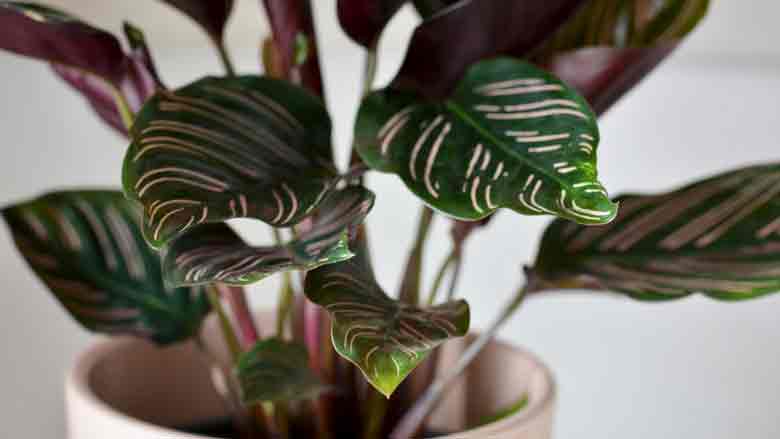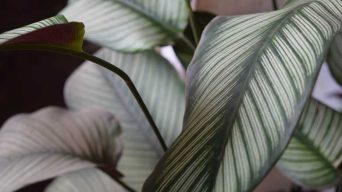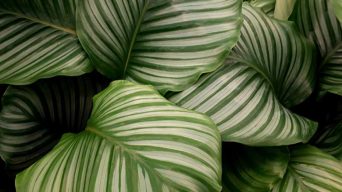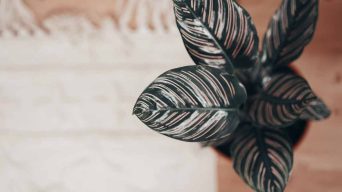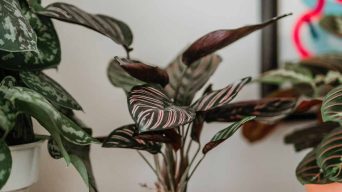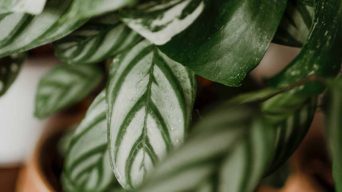Underwatering and low humidity are the two most common causes of Calathea leaves curling. Calatheas are sensitive plants that require a consistent watering schedule and plenty of humidity to thrive. In response to dehydration or low humidity, Calatheas will curl as a mechanism to reduce water loss.
Are your Calathea leaves curling, and you’re wondering what’s happening and how to fix it?
Curled leaves can be a sign of many different problems, from underwatering to pests.
Here we’ll discuss the causes of leaf curl in Calatheas and give you some solutions to correct the problem!
Why Calathea Leaves Curl
Growing Calantheas, commonly known as a prayer plant, is a relaxing and rewarding experience. Still, it’s not always easy to keep them looking their best.
You’re not alone if you’ve noticed that your Calathea leaves have started to curl.
This is a common problem with Calantheas, and there are several possible causes.
Below are some of the most common reasons Calathea leaves curl and solutions to correct the problem.
Underwatering
Calathea leaves curl to protect themselves from dehydration, a natural defense mechanism that helps minimize the amount of water lost through transpiration.
Many houseplants, including Calathea, rely on transpiration to help them regulate moisture levels.
Transpiration is the evaporation of water from plant leaves. It occurs when the plant’s roots take up water from the soil, and the water then moves up through the stem and into the leaves.
When a Calathea is underwatered, transpiration slows down, and the plant cannot get rid of excess moisture. This causes Calathea leaves to curl in an attempt to conserve water.
How To Fix It
Check the soil moisture level first if your Calathea is underwatered.
The top few inches of soil should be slightly damp but not wet. If the soil is dry, water the plant until the top of the soil feels moist.
Watering Calathea plants can be tricky because they don’t like to sit in waterlogged soil.
You’ll need to give your plant a good soaking, but let the soil dry before watering again.
Using a pot with a drainage hole to drain excess water is also a good idea.
Overwatering
On the other hand, overwatering can also cause Calathea leaves to curl.
When Calatheas are watered too frequently, the soil becomes waterlogged. It prevents the roots from getting the oxygen they need to thrive. This can cause the leaves to curl and turn brown at the edges.
Other signs of overwatering include yellow leaves, drooping plants, and a foul odor from the soil.
Watering Calathea plants too frequently can also cause root rot, so be careful not to overwater when the plant is dormant in the winter.
How To Fix It
If your Calathea is overwatered, wait until the top inch of soil dries out before watering again.
You can also check the soil’s moisture level by sticking your finger in it – if it’s wet, wait until it dries out a bit before watering.
Calathea plants need to be watered thoroughly, but they should never be saturated.
Make sure to give your Calathea plenty of time to dry out before watering again.
Low Humidity
Low humidity can also cause Calathea leaves to curl. They are native to tropical rainforests, where humidity levels are high.
When the air is too dry, plants will lose water through transpiration faster than they can replace it. This causes the leaves to shrink and curl inwards to conserve moisture.
Low humidity is a common problem in homes, especially during the winter. Heating systems tend to dry out the air, which can be especially harmful to Calathea plants.
Other signs of low humidity include brittle and dry leaves, brown leaf tips, and a general lack of vigor.
How To Fix It
The best way to combat low humidity is to increase the moisture in the air.
You can occasionally place your Calathea plant near a humidifier or spray it with water.
You can also add water to a tray of pebbles and place your Calathea plant on top.
The water’s evaporation will help increase the humidity around the plant.
You can also increase humidity levels by placing your plants in a bathroom or kitchen, typically more humid than in other parts of the house.
Too Much Sunlight
Too much sunlight can also cause Calathea leaves to curl.
While Calatheas prefer bright indirect light, they will sunburn if exposed to direct sunlight for too long.
The leaves will curl to protect themselves from the sun’s rays.
If Calathea leaves are badly sunburned, they will turn brown and eventually drop off.
Calatheas need about four hours of sunlight daily. Still, you should avoid putting them in direct sunlight during the hottest part of the day.
How To Fix It
If you think your Calathea is getting too much sun, move it to a location that will receive more indirect light.
Use a sheer curtain or place your plant in a partially shaded area to help reduce the amount of sunlight it receives.
If your Calathea is badly sunburned, you may need to move it to a new location until the leaves have healed.
Temperature Extremes
Temperature extremes can also cause Calathea leaves to curl. This is a natural defense mechanism that helps the plant prevent water loss.
In warm weather, Calathea leaves curl to reduce the surface area exposed to the sun. This helps the plant prevent water loss through evaporation.
In cold weather, Calathea leaves curl to protect the delicate tips from frost damage.
By curling its leaves, Calathea can minimize heat loss and reduce the surface area exposed to the cold air.
While extreme temperatures can cause Calathea leaves to curl, this is not harmful to the plant and is simply a way for the plant to cope with changes in its environment.
How To Fix It
The ideal temperature range for Calatheas is between 65 and 80 degrees Fahrenheit.
If your Calathea is affected by temperature extremes, try adjusting your home’s temperature accordingly.
You can also move your Calathea plant to a more suitable location for its needs.
If you live in a climate with extreme temperature changes, keep your Calathea indoors.
When the temperature is too hot, you can try to cool the plant down by misting it with water.
When the temperature is too cold, you can warm the plant up by placing it in a sunny location.
Pest Infestations
Pest infestations can also cause Calathea leaves to curl.
Aphids, mealybugs, and spider mites are common pests that can infest Calatheas.
These pests feed on the plant sap, causing the leaves to curl and eventually turn brown.
In addition to causing Calathea leaves to curl, pests can lead to other problems such as leaf drop and stunted growth.
How To Fix It
If you think pests are infesting your Calathea, you can eliminate them using organic methods.
You can try spraying the plant with a strong stream of water to dislodge the pests, or you can use a natural pesticide such as neem oil.
You can also get rid of pests by hand-picking them off the plant or using a horticultural soap.
If the infestation is severe, you may need an insecticide to eliminate the pests.
When pests have infested your Calathea, it is essential to treat the plant immediately to prevent further damage.
Water Quality
The water quality you use to water your Calathea can cause the leaves to curl.
The presence of elevated mineral levels, specifically calcium and magnesium, in hard water can lead to the yellowing and curling of Calathea leaves.
These minerals can build up on the leaves, causing them to curl and have yellow edges.
In addition, hard water can make it difficult for the plant to absorb moisture and nutrients.
Other problems that can be caused by hard water include wilting, leaf drop, and stunted growth.
As a result, Calatheas are best grown in soft water.
How To Fix It
If you think the water you are using to water your Calathea is causing the leaves to curl, you can try to soften the water.
You can do this by adding a water softener or using distilled water.
You can also water your Calathea with rainwater or bottled water.
If you live in an area where the water is hard, it may be necessary to use one of these methods to keep your Calathea healthy.
Overfertilization
Overfertilization can also cause Calathea leaves to curl.
When the plants are fertilized too frequently or with too much fertilizer, the salt levels in the soil build up. This can cause dehydration and damage to the prayer plant leaves, causing them to curl.
In addition, overfertilization can lead to other problems, such as leaf drop and stunted growth.
How To Fix It
If you think your Calathea is being overfertilized, you must flush the soil to remove the excess fertilizer.
You can water the plant with plain water and discard the runoff.
It is also important to fertilize your Calathea correctly using a low-salt fertilizer.
It would be best if you only fertilized your Calathea once a month during the growing season and not during the winter months.
When fertilizing your Calathea, you should be careful not to overfertilize it. This will help control the salt levels in the potting mix and prevent damage to the leaves.
If you have been overfertilizing your Calathea, it is essential to correct the problem immediately.
Why Are My Calathea Leaves Curling Inward?
One of the most common problems that Calathea owners face is leaves that curl inward.
Several possible causes for this problem range from environmental stress to pests.
However, the most likely cause of curling leaves is excessive sunlight.
If Calathea leaves are exposed to direct sunlight for extended periods, they will begin to curl inward to protect themselves from the harsh rays.
If you suspect that your Calathea’s leaves are curling due to excessive sunlight, the best action is to move the plant to a location with more filtered light.
Your Calathea should soon recover with proper care, and its leaves should return to normal.
Why Are My Calathea Leaves Curling After Watering?
If your Calathea’s leaves are curling after watering, the water you are using is likely too hard.
Calatheas prefer soft water, and hard water can cause the leaves to curl and turn yellow.
Other problems that can be caused by hard water include wilting, leaf drop, and stunted growth.
As a result, Calatheas are best grown in soft water.
If the water you are using to water your Calathea is causing the leaves to curl, you can try to soften the water by adding a water softener or using distilled water.
You can also water your Calathea with rainwater or bottled water.
Why Are My Calathea Leaves Curling After Repotting?
If your Calathea’s leaves are curling after repotting, likely, the plant is not getting enough water.
When a Calathea is repotted, its roots are exposed, and it can take some time for them to re-establish. It is essential to water the plant regularly, or it will begin to curl its leaves.
Another possibility is that the potting mix you are using is too dense.
A potting mix that is too dense will not allow the plant to get enough air, which can also cause the leaves to curl.
To prevent this from happening, make sure to use a potting mix that is light and well-drained.
Why Are My Calathea Leaves Curling and Drooping?
If Calathea’s leaves are curling and drooping, likely the plant is not getting enough water.
Calatheas must be watered regularly to stay healthy, as with most plants.
If the plant does not get enough water, it will start curling its leaves to conserve moisture.
The Calathea leaves will also droop as the plant begins to lose water.
To prevent this from happening, water your Calathea regularly and give it plenty of light.
Why Are My Calathea Leaves Curling and Turning Yellow?
Several factors could be causing the curling and yellowing of your Calathea leaves.
The most common reason is that the plant is overwatered.
Calatheas like to be kept moist but not wet. If the soil is too wet, the plant’s roots will rot, and the leaves will curl and turn yellow.
Another reason Calathea leaves curl and turn yellow is a lack of humidity.
Calatheas like high humidity levels, so if the air in your home is dry, the leaves will start to curl and turn yellow.
Why Are My Calathea Leaves Curling and Turning Brown?
There are several reasons why this may happen, ranging from environmental stressors to improper care.
One of the most common causes is overly dry air.
Calathea plants thrive in humid environments, so if the air around them is too dry, it can cause the leaves to curl and turn brown.
Another possible cause is direct sun exposure.
While Calathea plants need some bright light, too much direct sunlight can scorch their leaves, causing them to curl and turn brown.
Why Are My Calathea Leaves Curling and Crispy?
One of the most common problems with Calathea leaves is that they begin to curl and turn crispy.
There are several reasons why this may happen, but the most likely cause is stress from too much sun or insufficient water.
If Calathea leaves are left in direct sunlight for too long, they will begin to scorch and turn brown.
Similarly, if the plant is not getting enough water, the leaves will start to curl and turn crispy as the plant tries to conserve moisture.
Another possibility is that the soil is too dry or compacted, preventing the roots from getting enough water.
If you notice your Calathea leaves curling or turning crispy, try moving the plant to a shadier spot or increasing your watering frequency.
Why Do Calathea Leaves Curl at Night?
One of the most distinctive features of Calathea plants is their leaves, which are known for their brightly colored patterns and unique shapes.
However, Calathea leaves are also notable for their movements.
During the day, the leaves of Calathea plants are held upright, allowing them to maximize their exposure to sunlight.
However, the leaves begin to curl inwards at night, protecting the plant from excess moisture and preventing water loss.
This strange behavior is known as nyctinasty, and it helps Calathea plants to survive in conditions that would otherwise be too harsh.
As a result, Calathea leaves have evolved to be both beautiful and functional, making them a popular choice among plant enthusiasts.
Final Thoughts
The Calathea is a beautiful indoor plant that can bring life to any room. However, if your Calathea leaves start to curl, there are a few potential causes that you should investigate.
The most common cause of curling Calathea leaves is underwatering.
If your Calathea isn’t getting enough water, the leaves will start to curl up to conserve moisture.
Other potential causes of Calathea curling leaves include too much sunlight, low humidity, and pest infestations.
To treat it correctly, you need to identify the cause of the Calathea leaf curl.
Generally, Calatheas prefer medium to bright light, high humidity, and moist but not wet soil.
It is essential to keep these conditions in mind when caring for your Calathea and regularly inspect the plant for any signs of pests or disease.
If you follow these tips, your Calathea should stay healthy, and its leaves will stay curled no matter the cause.
Thanks for reading!

